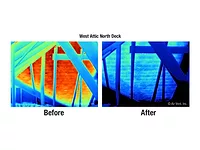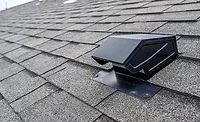How to Fight Ice Dams
A few hard, cold facts up front:
First: A water-protective membrane underneath shingles on a roof does not fight the formation of ice dams. It helps to minimize the damage the already formed ice dam will cause.
Second: It’s nearly impossible to prevent the formation of ice dams completely. Mother Nature – combined with complicated roof designs – make it a matter of when not if the next ice dam will form.
But it’s possible to reduce the frequency and severity of ice dams.
To find out how, Air Vent asked attendees of its free Attic Ventilation: Ask the Expert™ seminars offered to residential roofing contractors annually during the first quarter. We focused on roofing contractors with first-hand field experience making their living in northern climates. After all, who knows more about the potential problems freeze-thaw cycles can cause to a roof than roofers working in those very conditions?
Frequent Problem
An ice dam is a blockage of ice formed at or near the roof’s lowest edge. It develops when snow on a roof melts unevenly, primarily due to uneven roof deck temperatures. It usually starts near the peak where it’s warmest and refreezes when it reaches the lowest, coldest section of the roof. Any additional snow melt in the next hours or days runs into the ice dam – and the real trouble begins.
The draining water hits the dam and begins to back up, penetrating underneath and between roof shingles, finding cracks that can ultimately lead to an interior leak.
“One out of every three calls we receive are in some way related to ice dam issues, whether it’s to remove them or how to help prevent them in the future from recurring,” said Greg Pike, sales manager at RJK Construction, in Willoughby, Ohio.
When conditions are right, it’s a common problem for homeowners throughout the Midwest and northern states.
“Sixty to seventy percent of the customers that we see bring up the fact that they have had problems with ice dams during the winter months,” says Jeremy Bays, home improvement specialist at Bone Dry Roofing, of Indianapolis, Ind.
Some have turned the force of nature into a positive revenue stream.
“Our company, on average, receives five to eight calls a week from concerned homeowners looking for a way to eliminate or reduce the risk of ice dams,” said Freddy Campoverde, owner of Golden Group Construction Corp, in Worcester, Mass., which withstood record snowfall and frigid temperatures a year ago.
“If there is a period of long slow melting then we do not receive too many phone calls. But if there is a quick warm up and the freeze-thaw cycle is sped up or if there is any substantial rain with already frozen gutters, then the ice dam calls roll in,” added Sean Toms, quality control manager, S & K Roofing, Siding and Windows, in Eldersburg, Md.
The Damage
What exactly is found when responding to the phone calls?
“Consequences can range from waterlogged attic insulation to ruined ceilings and also damaged interior possessions,” said Chad Buck, senior sales representative with Bone Dry Roofing.
The roofing professionals polled shared an exhaustive list of potential ice dam-related problems:
- Damaged shingles
- Water damage to the overhang (soffit and fascia), roof deck (wood rot), interior walls and ceilings
- Wet attic insulation (which can reduce its R-Value)
- Damaged gutters
- Damaged interior floors
- Framing damage
- Mold
- Dangerous icicles dangling from the roof edge waiting to fall
- Ants (they are attracted to the moisture)
- Damage to personal property (inside the attic and house)
- Quality of life disruption while workers are onsite
“Many homeowners wait for the interior damage before making the crucial phone call,” Campoverde said. “However, what many homeowners don’t realize is that the damage to the wood decking and attic insulation has been occurring for quite some time, before they witnessed those first interior leaks. This makes the situation and repairs much more serious and expensive.”
While some resort to re-roofing due to the severity of the damage, that may not be the long-term fix needed.
“There’s a tendency for homeowners to want to have an entire roof replaced that is not past its service life as a solution to the ice dam issue. That’s not the answer,” Pike explained.
Others agreed.
“Replacing a roof will give you a new roof. But it will not solve the cause of the ice dam,” said Sam Rosario, president, Sam Rosario Construction in Worcester, Mass.
Fighting the Cause
So what will help the fight against ice dams?
Attacking the root cause. Every one of the roofing pros who participated in this article offered the same 1-2 punch to fight ice dams: balanced attic ventilation with equal amounts of intake and exhaust vents; and the proper level of attic insulation appropriate for the geographic climate.
“For me, the attack in reducing ice dams is to remove the warm air melting the snow. This is done with proper attic ventilation mixed with proper attic insulation,” says Charles Power, territory manager, Square Deal Building Supply in Sterling Heights, Mich.
Both are needed, but the attic ventilation is often the solution least understood, our panel of roofing pros said.
“Many homeowners think if they have a few small vents on the roof, their attic is now properly vented. But attic ventilation is a system of intake vents and exhaust vents so air can flow into the attic (low on the roof) and out (at or near the peak),” says Sue McCollum May, owner, A Better Way Construction LLC, in Lincoln, Neb.
“In my opinion, proper attic ventilation is a major player in the fight against ice dams,” said Bruce Akins, senior sales professional, Second To None Inc. of Parma, Ohio. “Ice dams are a result of heat melting snow which then freezes from low outside temperatures. The heat comes from the sun, which is unavoidable, and from the warm air trapped inside the attic, which is correctable. If the attic is properly ventilated and the heat is allowed to escape, the ice dams will be greatly reduced or totally eliminated.”
Other contractors reinforced the point.
“A properly ventilated attic will maintain the temperature of the roof deck, helping to keep it constant throughout the winter – even as temperatures warm up during the day and cool during the night,” says Campoverde.
Contractors must also be cautious to never mix two types of exhaust on the same roof above a common attic because it could short-circuit the system. Educating the homeowners continues to be a challenge, he added.
“The biggest obstacle we strive to overcome is educating homeowners on what a good attic ventilation system means,” Campoverde explained. “Many seem to think that a couple of box vents (roof louvers) and a gable vent is all you need. However, this is simply not true.”
Balanced and Continuous Airflow
A continuous ridge vent (exhaust) and a continuous soffit vent (intake) appear to be the most successful system in maintaining a properly and well ventilated attic.
“A well ventilated attic will help fight against ice dams and protect the house from those costly repairs,” Campoverde said.
“Attic ventilation plays a big role in fighting ice dams,” says Buck. “Balanced ventilation allows the roof to breathe properly so the snow can stay on the roof and melt normally (evenly).”
That’s because the attic ventilation introduces cooler outdoor air into the attic through the intake vents which flush out warm, moist air through the exhaust vents in the winter. As a result, the overall attic temperature is closer to the ambient outdoor temperature along the entire underside of the roof — reducing the roof’s hot and cold spots that invite ice dams.
Shawn Bellis, owner of EPIC Exteriors in Kansas City, Kan., said the most critical portion of the overall attic ventilation system is the intake vents. “It’s the first step in fighting ice dams – the intake vents. In almost every case when we add the proper amount of intake vents to make the overall attic ventilation system balanced, the ice dam problems are solved.”
Other roofing contractors weighed in with the following:
- “I can personally say attic ventilation is the best method for fighting ice dams,” according to David Allen, owner, Allen Roofing in Mt. Pleasant, Mich. “For all the roofs we’ve done, none have had ice dams that have caused damage.”
- “The only way to stop ice dams is to vent the attic correctly,” Rosario said. “Making sure you have a balanced attic ventilation system and the correct insulation is the only way to solve the ice dam issue.”
- “Proper attic ventilation also removes the moisture from the attic to help prevent water vapor from condensing on the attic side of the roof deck,” Power explained. “This moisture then can freeze and could result in an ‘interior ice dam,’ which could lead to more rot and mold to deal with.”
Don’t Forget Insulation
But don’t be mistaken, it’s the combination of attic ventilation and insulation that best fights ice dams and Mother Nature. One without the other is ineffective.
“We always explain to homeowners they must have the required amount of insulation in their attic to avoid heat loss from the home’s interior, which is a large contributor to ice dam formation,” Toms said.
“Attic insulation helps keep the warm air in the house interior and out of the attic,” Power explained. “But some of that warm air will still escape into the attic. Once there, proper attic ventilation will help remove it, reduce the attic temperature and help to keep the snow melting evenly and naturally on the roof.”
Remember, there’s some degree of inevitability when it comes to this problem.
“If an attic is well ventilated but poorly insulated, ice dams can still occur. Likewise, if an attic is well insulated but not well ventilated, ice dams can still occur,” says Campoverde.
And if the ice dam still happens despite balanced attic ventilation and sufficient attic insulation, the water protective membrane underneath the shingles helps to minimize any damage.
Additionally, RJK Construction checks gutter size.
“We recommend that our customers upgrade to a larger 6-inch gutter and a 4-inch downspout to more effectively move a larger volume of water away from the roof and house,” Pike added.
Looking for a reprint of this article?
From high-res PDFs to custom plaques, order your copy today!








